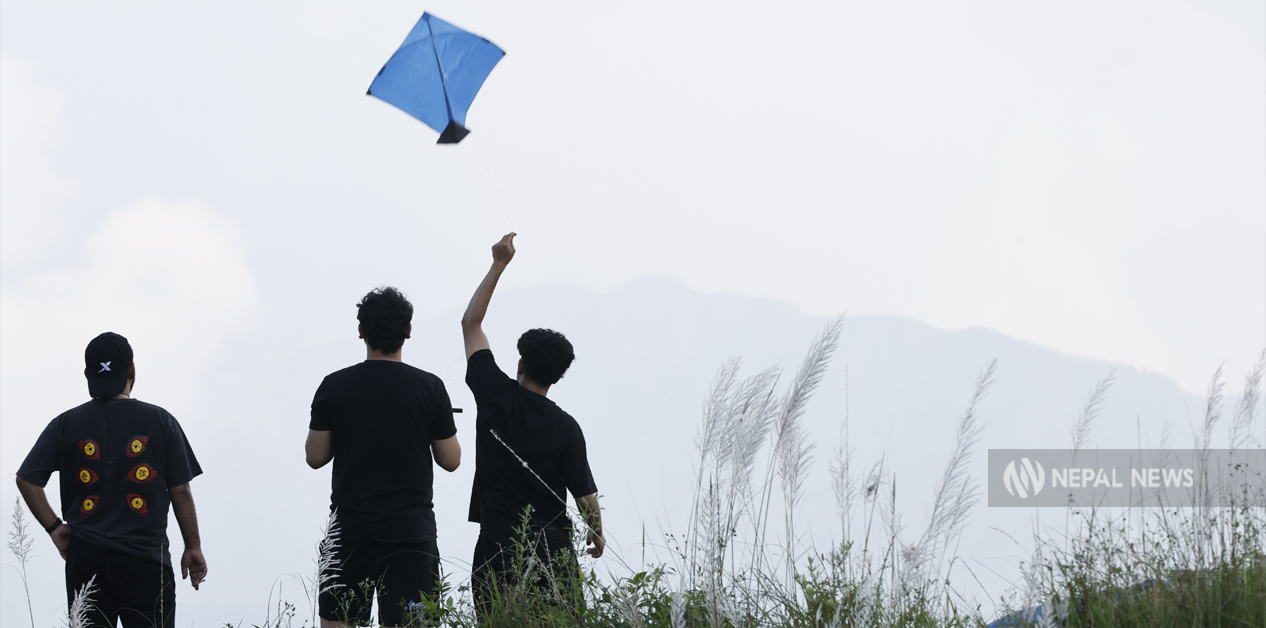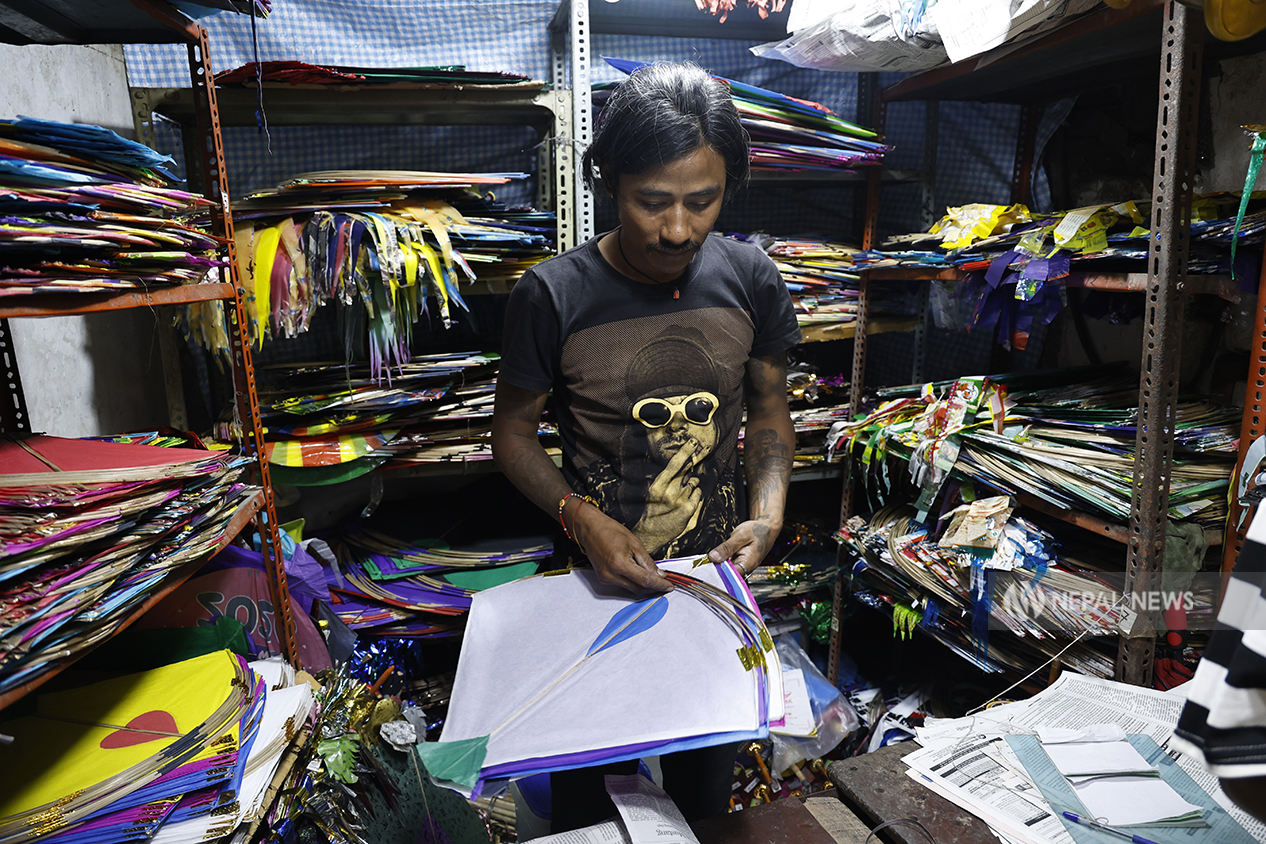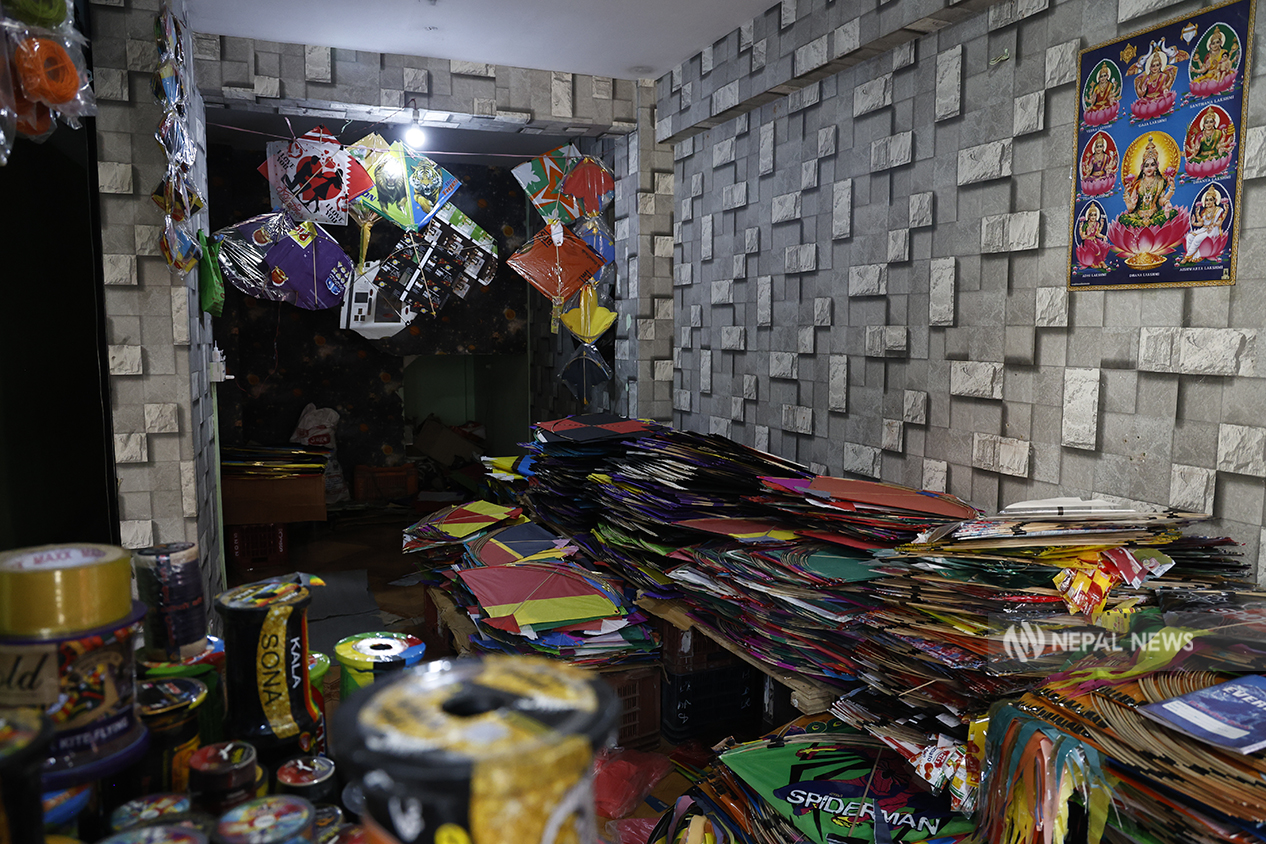

All the mud and slush are gone,
The rainfall has vanished,
The goddess Bhawani has been worshipped,
And the rain of joy has begun.
Wherever you go, everyone says,
Dashain has come, Dashain has come.
This joyous chatter of the festival,
Has made everyone forget their troubles.
Poet Lekhnath Paudyal saw Dashain this way—clear skies without rain or mud, villages buzzing with the talk of Dashain, the excitement of flying kites and swinging on swings.
But in recent years, kites have hardly been seen in the skies during Dashain.
There was a time when, many days before Dashain, the skies over Kathmandu Valley were filled with kites like flocks of birds.
The colorful kites decorating the skies themselves signaled that the festival had arrived!

Rakesh Shrestha selling kites in Ason. Photo: Bikram Rai/Nepal News
Now, when the skies look empty, people who once associated Dashain with kites feel something missing in the festival.
That is exactly how Ram Kunwar of Pharping Bhanjyang, Kathmandu, feels. Seeing the culture of kites fading, he finds Dashain dull and worries that the tradition may disappear altogether.
The 51-year-old recalls his childhood: “We used to start saving money to buy kites right after June ended and by July, we would buy kites and string.”
When he sees today’s children hooked to mobile phones, he feels they are missing the real taste of festivals.
In his childhood, Kunwar had plenty of friends. Together they would run from Pharping to Ason to buy kites.
They made their own spools (lattai). “Having just five rupees made us feel like we had everything. It was enough to buy kites for the entire Dashain,” he said with a smile.
Until around the age of 35, he celebrated Dashain by flying kites this way.
Gradually, his circle of friends in Pharping Bhanjyang disappeared, and with them, the kite-flying craze also faded.
In the meantime, the fields of Bhanjyang turned into housing plots.
Open fields are now rare. The new generation has shrunk into the fun of television and mobile technology.
With kite culture disappearing, Kunwar retreats into memory, satisfying himself with the sweet taste of his childhood.
He is not just disappointed at the community level, but also at home, where the younger generation has forgotten kites and swings, immersed in the digital world.
“Even my own son is busy with his mobile. Today I had to insist that he come and fly a kite,” he said, pointing to his son flying a kite on the hill at Chobhar. “These days, it’s mostly the elders who fly kites—you hardly find children or youths doing it.”
Although kites are seen as a fun game in many places, within Kathmandu Valley kite culture is tied to Dashain.
It is regarded as part of the Newar community’s autumn tradition.
By September, paddy stalks are already bending with grain and no longer need water.
At such a time, there is a folk tradition of flying kites to send a message to Indra, the god of rain and prosperity, saying: “The crops have enough water.”
Believers say that upon hearing this, Indra stops the rain. “This is exactly what Poet Paudyal expressed in his poem: ‘All the mud and slush are gone, the rainfall has vanished.’
After that, Dashain arrives, the skies clear, and in the cool weather, kites are flown in courtyards, rooftops, and open spaces,” says cultural expert Tejeswor Babu Gongah.
For Gongah:, kites feel like a part of life itself. Now 92 years old, he remembers: “Earlier, rooftops, courtyards, and fields were crowded with children flying kites. Even if I cannot fly them now, I still enjoy seeing others fly.”
In Nepal Bhasa, kites are called Bhutimali. They are made from paper or plastic. Gongah still recalls the days of childhood when boys competed to cut each other’s kites by applying paste (majha) of ground glass and starch to the string.
When someone’s kite was cut, children would scream “Chet!” in victory, shaking the whole neighborhood.
Sometimes even brothers’ kites clashed, leading to quarrels, though they would later search together for the lost kite.
Such memories show that kite-flying was not just a game, but also a bond of relationships and emotions.
Now, however, that color and emotional thread of the festival has become rare.
Due to a lack of open spaces and alternative entertainments, children and youths no longer feel drawn to kites.
Until a few years ago, kite competitions were held in Kathmandu in connection with tourism, but now even that has disappeared.
Still, as traditions fade, some youths deliberately make time and plans to go kite-flying in the hills of the Valley.
Last Thursday, Nepal News met a group of such friends in Chobhar. Among them was Ayush Khatri from Kapan, who said he had come up there because the dense urban settlements in the city center left no empty spaces.
“It’s hard even to find friends to fly kites with. And good-quality kites, spools, and strings cost at least 6–7 thousand rupees, so many people don’t bother,” he said.
Different types of kites
Kites are made in triangular, square, and leaf-like shapes.
Strings and spools are used to fly them. The kites and strings children use are simple, while enthusiasts use special ones.
The quality and names of kite strings vary. Paste (majha) made of starch mixed with powdered glass is applied to the strings.
The better the paste, the more expensive the string.
Spools (lattai) are made from wood and bamboo, and they come in two types: rotating and fixed.

Kites on display at a shop in Kalimati. Photo: Bikram Rai/Nepal News
Ayush, met in Chobhar, had brought a large rotating spool and a leaf-pattern kite.
“The kite costs Rs. 70, but the spool cost Rs. 2,000, and the khukuri string Rs. 5,500,” he said. “If the kite gets cut, it’s gone, and the string unravels and gets spoiled.”
Until four or five years ago, every grocery store in Kathmandu stocked kites, spools, and strings. Now, they are found only in limited places.
Ason-based wholesale and retail kite seller Rakesh Shrestha said the business has declined drastically. “A few years ago, there used to be crowds coming to buy kites—I didn’t even have time to go to the toilet. Now, only a handful come,” he said.
According to Shrestha, about five years ago, he sold nearly 5,000 kites and around 500 spools daily. Now, it’s hard to even sell 700 kites in a day.
He said most kites flown in Nepal are imported from Kolkata, Lucknow, and Patna in India.
Recently, some are also imported from China, while a few are made in Nepal.
Prices vary by size and type. Kite enthusiasts usually prefer large paper kites, while most others buy smaller plastic kites.
Strings are imported from India and Pakistan, though paste (majha) is also applied to strings in Nepal.
Prashansa Shrestha of Lokanthali, Bhaktapur, who had come to Ason to buy kites for her shop, also said the kite business has been disappointing.
Until a year ago, she used to take 2,000 kites and sell them within a week. But now, even 100 are hard to sell.
“After the Gen Z movement on September 8 and when schools closed, kite sales picked up a bit. But once schools reopened and then Dashain holidays began, children went back to their villages, and business came to a complete halt,” she said.